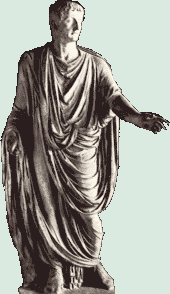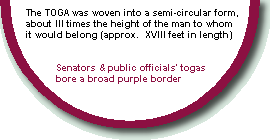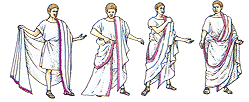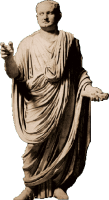Villa Ivlilla's Toga Page is featured as part of KiddoNet's Detective Mystery game on ancient Rome. Multas gratias, KiddoNet!
|
 |

|
 |
When any illustrious member dies, the family takes the images to the funeral, puting them on...actors [who] put on a purple-bordered toga if their character was a consul or praetor, an entirely purple toga of he was a censor, and a gold-embroidered toga if he had celebrated a triumph.
Polybius, History of the World 6.53-6.5.4.3
|
|
 |
 |
- "...but I am inclined to agree with those who think that as this class of public officers was borrowed from the same people from whom the sella curulis and the toga praetexta were adoptedtheir neighbours, the Etruscans."
-
Livy, History of Rome, I, VIII
|
|
 Much as Roman clothing can be said to resemble that of the Greeks, the toga is distinctive to Romans. The toga is descended from the Etruscan tebenna, (Livy I.VIII) and in the early days of Rome was probably woven of coarse, undyed wool. Later though the toga was woven from, soft wools, linens even silk during the late Roman empire. Much as Roman clothing can be said to resemble that of the Greeks, the toga is distinctive to Romans. The toga is descended from the Etruscan tebenna, (Livy I.VIII) and in the early days of Rome was probably woven of coarse, undyed wool. Later though the toga was woven from, soft wools, linens even silk during the late Roman empire.
The toga was never worn by itself, unlike its cousin, the Greek himation. It was worn always over a tunica, which in the republic and early empire, bore clavi - broad vertical stripes - borrowed from the Etruscans.
Begun as a strictly utilitarian garment, the toga evolved into a ceremonial robe the carried such overtones of the Roman qualities of dignitas and gravitas that in later times it was seldom worn except on state occasions. Only citizens with voting rights could wear it, and colour and decoration was strictly regulated according to status.
|
|

Wearing the Toga
- "Ipse togam rotundam, et apte caesam velim."
-Quintilian IX, III, CXXXVII


| Drape the left- hand end over the left shoulder |
Fold the right hand end over in the middle, gather it into a roll and throw it over the left shoulder. |
The rest of the right- hand piece is folded and thrown over the left shoulder. |
A part of the left- land piece is pulled up and tucked into the belt. |
|
- Miserat duas pmetorias cohortis Caesar, addito ut magistratus Calabriae Apulique et Campani suprema erga memoriam filii sui munera fungerentur. igitur trlbunorum centurionumque umeris cineres portabantur; praecedebant incompta signa, versi fasces; atque ubi colonias transgrederentur, atrata plebes, trabeati equites pro opibus loci vestem odores aliaque funerum sollemnia cremabant.
Tacitus, Annales III
 Candidates for public office wrapped themselves in the toga candida, rubbed with chalk to render it a dazzling white, to signify the purity of their intentions. Candidates for public office wrapped themselves in the toga candida, rubbed with chalk to render it a dazzling white, to signify the purity of their intentions.
Augurs and certain priests wore the toga trabea, decorated with scarlet and saffron stripes. Victorious generals (and later emperors and consuls) were awarded the purple toga picta, embroidered with palm leaves. Mourners wrapped their grief in an inky toga pulla.
Fate of the Toga
As the Republic ballooned into an empire, so expanded the toga, until it measured XX feet in length, and VII - X feet in width; no doubt causing Tertullian to complain, "This is no garment but a burden."
Officials continued to wear the toga until the fifth century, but after the fall of the Empire, it had shrunk to a mere VI feet in length, and the average Roman citizen had given up on the toga altogether, bringing it out only for festivities and funerals.
Sources
A History of Costume, Rachel Kemper
Historic Costume, Katherine Lester
A History of Costume, Clark Kohler
The Romans: Their Life & Customs,
E. Guhl & W. Koner
See also Richard Heli's excellent Toga Page
|
|
|
|
 |
|


 Much as Roman clothing can be said to resemble that of the Greeks, the toga is distinctive to Romans. The toga is descended from the Etruscan tebenna, (Livy I.VIII) and in the early days of Rome was probably woven of coarse, undyed wool. Later though the toga was woven from, soft wools, linens even silk during the late Roman empire.
Much as Roman clothing can be said to resemble that of the Greeks, the toga is distinctive to Romans. The toga is descended from the Etruscan tebenna, (Livy I.VIII) and in the early days of Rome was probably woven of coarse, undyed wool. Later though the toga was woven from, soft wools, linens even silk during the late Roman empire.

 Candidates for public office wrapped themselves in the toga candida, rubbed with chalk to render it a dazzling white, to signify the purity of their intentions.
Candidates for public office wrapped themselves in the toga candida, rubbed with chalk to render it a dazzling white, to signify the purity of their intentions.